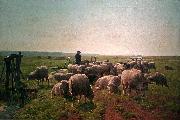 |
Cornelis Van Leemputten -- Click Here
|
|
(1841-1902) was a Belgian painter.
Born in Werchter, Cornelius van Leemputten is predominantly known for his landscapes with sheep, similar to the style of Charles Jacque. He began his painting career without formal training. He was well-known for his barnyard subjects. Leemputten eventually became a pupil of the Academy of Antwerp, though his style remained primarily self-taught.
Van Leemputten participated across several international exhibitions and received gold medals in Ghent in 1883, Edinburgh in 1886, Port Adelaide in 1887 and in Berlin in 1896. In 1895, he received the Knight of the Order of Leopold (Belgium).
|
|
 |
CORNELIS VAN HAARLEM -- Click Here
|
|
Dutch painter (b. 1562, Haarlem, d. 1638,
Dutch painter and draughtsman, was one of the leading Northern Mannerist artists in The Netherlands, and an important forerunner of Frans Hals as a portraitist. Cornelis Corneliszoon was a member of the Mannerist school of Haarlem, which was highly influenced by the work of Bartholomeus Spranger, whose drawings were brought to Haarlem by Carel van Mander in 1585, and had a strong immediate effect.[1] He painted mainly portraits as well as mythological and Biblical subjects. Initially Corneliszoon painted large-size, highly stylized works with Italianate nudes in twisted poses with a grotesque, unnatural anatomy. Later, his style changed to one based on the Netherlandish realist tradition. When his parents fled Haarlem in 1572, as the Spanish army laid siege to the city during the Eighty Years' War, Corneliszoon remained behind and was raised by the painter Pieter Pietersz., his first teacher. Later, Corneliszoon studied in Rouen, France and Antwerp, Belgium. Corneliszoon in 1583 received his first official commission from the city of Haarlem, a militia company portrait, the Banquet of the Haarlem Civic Guard. He later became city painter of Haarlem and received numerous official commissions. As a portrait painter, both of groups and individuals, he was an important influence on Frans Hals. Together with Carel van Mander, Hendrick Goltzius and other artists, Corneliszoon formed the Haarlem Academy or "Haarlem Mannerists". Probably this was a very informal grouping, perhaps meeting to draw nude models, and certainly to exchange artistic views.[2] Corneliszoon also played a role in reorganizing the Haarlem artists' and artisans' Guild of St. Luke, eliminating its medieval organization and raising the status of the artists. Corneliszoon married Maritgen Arentsdr Deyman, the daughter of a mayor of Haarlem, sometime before 1603. |
|
 |
Cornelis van Dalem -- Click Here
|
|
1535-1576
Dutch
Cornelis van Dalem Location
Flemish painter. He was the son of a well-to-do cloth merchant living in Antwerp, but of Dutch origin. Cornelis received a humanistic education. His father, who owned land in Tholen, as a vassal to the Counts of Holland and Zeeland, was dean of the chamber of rhetorics De Olijftak (The Olive Branch) in Antwerp in 1552-3. According to van Mander, Cornelis was himself learned in poetry and history and only painted as an amateur, not for a living. Documents in the Antwerp archives invariably refer to him as a merchant, never as a painter, which no doubt accounts for the small number of known paintings by him. He learnt to paint with an otherwise unknown artist, Jan Adriaensens, who had also taught his older brother Lodewijk van Dalem ( fl 1544-85). The latter was inscribed as a pupil in 1544-5 and became a master in the guild in 1553-4. Cornelis was himself inscribed a year after his brother, and he became a master in 1556, the same year he married Beatrix van Liedekercke, a member of an Antwerp patrician family. They lived in Antwerp until late 1565, when, apparently for religious reasons, they left for Breda, together with the artist mother, who had become a widow in 1561. In 1571 several local witnesses testified that van Dalem, who was then living in a small castle, De Ypelaar, in Bavel, near Breda, was strongly suspected of being a heretic. He was never seen in church and was said, on the contrary, to have often attended Protestant services and to have publicly expressed contempt for Papists. |
|
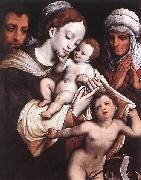 |
Cornelis van Cleve -- Click Here
|
|
painted Portrait of Jan Wyts in 16th century
|
|
 |
Cornelis Saftleven -- Click Here
|
|
(c. 1607, Gorinchem - 1 June 1681, Rotterdam) was a Dutch Golden Age painter
He was born into a family of artists, and learned to paint from his father Herman, along with his brothers Abraham and Herman Saftleven the Younger. He lived for a time in Utrecht with his brother.
Saftleven's subject matter covered various subjects, including genre works, portraits, beach scenes, and biblical and mythological themes. Some consider his images of Hell to be his most individual contribution to Dutch painting
|
|
 |
Cornelis Norbertus Gysbrechts -- Click Here
|
|
(ca 1630 - after 1683) was a Flemish painter of still life and trompe-l'œil active in the second half of the seventeenth century.
Gysbrechts was born in Antwerp, where, according to the RKD, he became a member of the Guild of St. Luke in 1660. He signed his name with "CND". His first known paintings date from 1659 in Antwerp. He painted in 1664 in Regensburg, from 1665-1668 in Hamburg and from 1668 to 1672 at the court in Copenhagen. |
|
 |
Cornelis Massijs -- Click Here
|
|
painted Hl. Hieronymus in einer Landschaft in 1547 |
|
 |
Cornelis Lieste -- Click Here
|
|
painted Landscape with Crescent Moon in |
|
 |
Cornelis Ketel -- Click Here
|
|
Flemish (Resident in UK)
1548-1616 Cornelis or Cornelius Ketel (Gouda, 18 March 1548 ?C Amsterdam, 8 August 1616) was a Dutch Mannerist painter, active in Elizabethan London from 1573 to 1581, and in Amsterdam from 1581 to the early 1600s, now known essentially as a portrait-painter, though he was also a poet and orator, and from 1595 began to sculpt as well.
According to Ketel's biography, written by his contemporary Karel van Mander, he seems to have wanted to concentrate on the most prestigious of the hierarchy of genres, history painting, which included mythological subjects, but after he left France he is known almost entirely as a portrait-painter. Neither England nor Holland had much demand for large history paintings during his lifetime, and none of Ketel's histories or allegorical paintings are known to have survived intact, although drawings and prints survive. He did however significantly influence the development of the largest type of painting commonly produced in the United Provinces at this period, the civic group portrait
|
|
 |
Cornelis Jonson -- Click Here
|
|
Cornelis I Jonson Van Ceulen
(1593 -1661 ) - Painter |
|
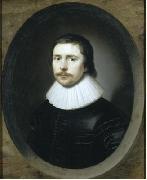 |
Cornelis Janssens van Ceulen -- Click Here
|
|
(also Cornelius Jonson van Ceulen, Cornelius Johnson, Cornelis Jansz. van Ceulen and many other variants)(bapt. October 14, 1593, London - bur. August 5, 1661, Utrecht) was an English painter of portraits of Dutch or Flemish parentage. He has been described as "one of the most gifted and prolific portrait painters practising in England during the 1620s and 1630s".
Janssens van Ceulen was born to Dutch or Flemish parents in London - his father had been a refugee from Antwerp, and the family had originated in Cologne. He was baptised at the Dutch church at Austin Friars, the son of Johanna le Grand and Cornelius Johnson. He may have been trained in the Netherlands, and was certainly influenced by other artists from the Netherlands, but he was active in England, at least from 1618 to 1643. In the 1620s, he lived and had his studio in Blackfriars, London, as did Anthony van Dyck; it was just outside the boundaries of the City of London, and so avoided the monopoly in the City of members of the London painters' Guild. He married Elizabeth Beke of Colchester in 1622. Janssens' son (Cornelius Janssens, junior) was born in 1634. He was also a painter. Janssens' daughter was married to Nicholas Russell of Bruges. Janssens moved to Canterbury in the mid 1630s, living with Sir Arnold Braems, a Flemish merchant. Janssens continued to live in England until after the outbreak of the English Civil War, but in October 1643, apparently at the insistence of his wife, he moved to Middelburg, and between 1646 and 1652 he lived in Amsterdam, before settling in Utrecht, where he was buried. |
|
 |
Cornelis Holsteyn -- Click Here
|
|
(1618 - 2 December 1658) was a Dutch Golden Age painter from Haarlem.
According to the RKD he was a painter of historical allegories, portraits, and interior decorations, trained by his father Pieter Holsteyn I. According to Houbraken, his father was a glass painter, and thus was trained for glass painting, but the market in glass painting not being what it was, he turned his hand to painting canvas. Houbraken felt he received less for a painting than he deserved, because his work was of a very high quality. He describes a Triumph of Bacchus, and a Lycurgus, which was painted for the Amsterdam Orphanage.
According to the RKD, he moved to Amsterdam with his brother Pieter Holsteyn II in 1647, became poorter there in 1652, and was betrothed there on Christmas eve, 1654. He was buried in the Nieuwe Kerk on December 2, 1658 from his home on the Rozengracht. Houbraken claimed he had been fit until his sudden death by Hartvang, or heart-attack.
|
|
 |
Cornelis Hendriksz Vroom -- Click Here
|
|
(1591, Haarlem - buried September 16, 1661, Haarlem) was a Dutch Golden Age landscape painter.
According to the RKD he was the son of the painter Hendrick Cornelisz Vroom, the older brother of Frederick and Jacob, and the father of the painter Jacob Cornelisz Vroom.[1] He became a member of the Haarlem Guild of St. Luke in 1634.
According to Houbraken in 1718, who repeated a list of names from Theodorus Schrevelius's 1648 book on Haarlem called Harlemias, he was the son of Hendrick Cornelisz Vroom and a good landscape painter of Haarlem along with "Joh. Jakobsz.", who was in Italy for many years, "Nicol. Zuyker", Gerrit Claesz Bleker, Salomon van Ruysdael, and Reyer van Blommendael. |
|
 |
Cornelis Dusart -- Click Here
|
|
1660-1704 Dutch
Dutch painter, draughtsman and printmaker. He was the son of the organist at St Bavo in Haarlem and one of the last pupils of Adriaen van Ostade. He became a member of the Haarlem Guild of St Luke on 10 January 1679 and served as its dean in 1692. Dated pictures by Dusart have survived from almost every year between 1679 and 1702. Two of his earliest pictures of peasants relied heavily on compositions by van Ostade: Mother and Child (1679; Dresden, Gemeldegal. Alte Meister) and Woman Selling Milk (1679; sold Amsterdam, Muller, 16 Oct 1928, lot 9; the original drawing by van Ostade is in Paris, Fond. Custodia, Inst. Neer., see Schnackenburg, 1981, no. 132). |
|
 |
Cornelis de Wael -- Click Here
|
|
Cornelis de Wael (1592-1667) was a Flemish painter of the Baroque period, active mainly in Italy, specifically Genoa. He was born in Antwerp, the son of a painter, and died in Rome.
|
|
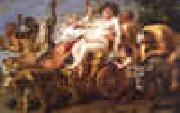 |
Cornelis de Vos -- Click Here
|
|
1585-1651
Flemish
Cornelis de Vos Gallery
Flemish portrait and figure painter. He was a contemporary of Rubens, who sent many sitters to him. Although of the school of Rubens, Vos developed an individual style of portraiture in which cool grays predominate. His representations of children were particularly successful. An example of his many portraits is that of Abraham Grapheus (Antwerp). His brother, Paulus de Vos, c.1596?C1678, was an excellent painter of animals and hunting scenes. His paintings show the influence of his brother-in-law, Frans Snyders. His work is best seen in the museums of Madrid and St. Petersburg. |
|
 |
Cornelis de Man -- Click Here
|
|
(Delft, 1 July 1621 - Delft, 1 September 1706) was a Dutch Golden Age painter.
Kornelis was not satisfied with life in Delft. He wanted to travel beyond the port of Dordrecht and that is what he did, spending a year in Paris as soon as he came of age and had enough talent to pay his way with his painting skills. He was well-received, but set off in the Spring for Lyon in order to cross Lombardia and the mountains before another winter set in. He settled for two years in Florence, where he had a rich patron, but stayed the longest in Rome. On the way back home he stopped in Venice, and in the end was gone for a total of nine years |
|
 |
Cornelis de Heem -- Click Here
|
|
Dutch Baroque Era Painter, 1631-1695
Son of Jan Davidsz. de Heem. He spent a great deal of his life in Antwerp, where he was taught by his father. Cornelis also worked in Utrecht in 1667, in nearby IJsselstein in 1676 and in The Hague from 1676 for more than ten years. His best works approach the quality of his father, particularly in works executed during the decade starting in 1655. Cornelis still-lifes can be distinguished by daring colour harmonies, sometimes with a strong blue. His compositions are often simpler: fruit-pieces, floral bouquets, festoons and garlands and sumptuous still-lifes, only occasionally in large formats. His technique changed from a more painterly to a more graphic style. |
|
 |
Cornelis de Baellieur -- Click Here
|
|
Cornelis de BAELLIEUR (Flemish) Antwerp 1607-1671. |
|
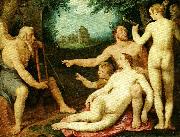 |
cornelis cornelisz -- Click Here
|
|
(1562-1638). Dutch painter |
|
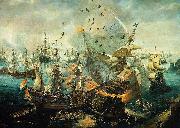 |
Cornelis Claesz. van Wieringen -- Click Here
|
|
He was the son of a Haarlem captain, and drew, painted and etched with his friends Hendrick Goltzius and Cornelis van Haarlem. He also held important positions in the Haarlem Guild of St. Luke, the painters guild, where he became a member in 1597.
He specialized in paintings depicting ships and sea battles, and received orders from the municipal councils of Haarlem and Amsterdam. He painted the most popular picture of the Damiate legend of Haarlem, showing how a Haarlem ship broke the protective chain at Damietta during the Fifth Crusade, resulting in an important victory over Islam. This painting was such a success that it was reordered in tapestry form, and both pieces are in the collection of the Frans Hals Museum.
The city of Haarlem archives still hold the original records of the 1629 order to Van Wieringen to make the tapestry, the largest made in the 17th century (10.75 meters long and 2.40 meters high). This tapestry still hangs on the wall of the Haarlem City Hall council meeting room known as the vroedschapskamer, where it was installed. It is on public display once a year on Monument Day.
|
|
 |
Cornelis Bol -- Click Here
|
|
Dutch, born circa 1589-1666,Painter, etcher and draughtsman, active in London. He was probably from a family of painters originating in Mechelen who later settled in Antwerp. Bol and his wife were members of the Dutch Church in London in 1636. An etching of an Action between the Dutch and Spanish Fleets (Oxford, Bodleian Lib.) is signed and dated 1639, and a set of etchings by him after Abraham Casembrot ( fl c. 1650-75) includes a view of Lambeth Palace as well as four imaginary Mediterranean seaports. A signed drawing of the Blockhouse at Gravesend is in the British Museum, London. George Vertue saw at Wotton House, Bucks, 'three views of London from the River side Arundel House Somersett house Tower Lond. painted before the fire of London by Cornelius Boll: a good free taste'. They were probably commissioned by John Evelyn, the diarist, around 1660 and descended in the Evelyn family. Their attribution to Bol is confirmed by a signed version of Somerset House (London, Dulwich Pict. Gal.). Although Bol was only moderately accomplished, he was able to reproduce the distinctive light and character of the River Thames and to render the riverside and its landmarks with much topographical detail; his pictures make pleasing visual documents. The handling of the naval craft is identical in a small signed oil panel of an Action between Dutch and Spanish Ships (Amsterdam, Rijksmus.) and in other marine subjects that have appeared in London salerooms. According to Immerzeel, Bol was still working in London at the time of the Great Fire in 1666. |
|
 |
Cornelis Bisschop -- Click Here
|
|
In ca. 1650 he was a student of Ferdinand Bol in Amsterdam. In 1653 he was back in Dordrecht, where he got married. According to Houbraken he was the first to paint carved trompe l'oeil wooden panels in such an ingenious way that they became quite popular. He painted historical allegories, portraits, still lifes, and genre-works. He was asked to paint for the Danish court, but he died unexpectedly, leaving his wife and eleven children. Of these children, two sons (Abraham (1660-1700) & Jacobus Bisschop (1658-1698)) and three daughters became painters. These had been his students when he died, and Margaretha van Godewijk studied with his daughters. She wrote an emblem about his self-portrait with a curtain, which illustrates the legend of Zeuxis.
His son Jacobus later became a student of Augustinus Terwesten in the Confrerie Pictura
|
|
 |
Cornelis Bega -- Click Here
|
|
1632-1664
Dutch
Cornelis Bega Galleries
Dutch painter, draughtsman and etcher. He was born into prosperous circumstances; his mother, Maria Cornelis, inherited half the estate (gold, silver, paintings, drawings and prints) and all of the red chalk drawings of her father, Cornelis Cornelisz. van Haarlem, a renowned Mannerist artist. Begas father was Pieter Jansz. Begijn (d 1648), a gold- and silversmith. Like other family members, Bega was probably Catholic. Houbrakens claim that Bega studied with Adriaen van Ostade is likely to be correct; this was probably before 24 April 1653, when Bega joined Vincent Laurentsz. van der Vinne in Frankfurt for a journey through Germany, Switzerland and France. Bega had returned to Haarlem by 1 September 1654, at which time he joined the Guild of St Luke; he was already a competent draughtsman, as indicated by his first extant dated work, Interior with a Nursing Mother (1652; Frankfurt am Main, Stedel. Kstinst.), and by a remarkable double portrait (Amsterdam, Rijksmus.) drawn by him and Leendert van der Cooghen in 1654.
|
|
|
|
 |
Corneille Huysmans -- Click Here
|
|
1648-1727
Flemish
Corneille Huysmans Galleries
|
|
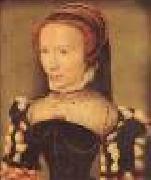 |
CORNEILLE DE LYON -- Click Here
|
|
Dutch-born French Northern Renaissance Painter, 1500-1575
Dutch painter, active in France. It is uncertain whether he was apprenticed in his native city of The Hague or in Antwerp, and nothing is known of him before 1533, when he was recorded in Lyon. It was possibly in the same year, while the French court was resident in Lyon, that Corneille was made painter to Queen Eleanor, the second wife of Francis I. In 1541 Corneille was painter to the Dauphin (later Henry II), and when the new king succeeded to the throne (1547) and made his state entry into Lyon in 1548, Corneille became Peintre du Roi. Corneille had obtained his naturalization papers in December 1547 and retained French nationality for the rest of his life. He married Marguerite Fradin, the daughter of a Lyon printer of some importance, and this allowed him to enter Lyon society. His studio was extremely prosperous until c. 1565, the year he is known to have visited Antwerp, but disappeared completely after his death despite the fact that he founded a dynasty of painters. His sons Corneille de La Haye II (b 1543) and Jacques de La Haye and his daughter Cl?mence de La Haye were all painters, and the family continued to be known for its artists until the 18th century. Corneille de Lyon was a Protestant, like all those in the circles in which he moved, and it may be that the decline of his fortunes in the 1560s |
|
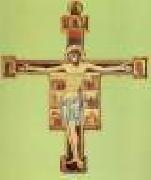 |
COPPO DI MARCOVALDO -- Click Here
|
|
Italian Byzantine Style Painter, ca.1225-1274 |
|
 |
COPLEY, John Singleton -- Click Here
|
|
American Colonial Era Painter, 1738-1815
American portrait painter, b. Boston. Copley is considered the greatest of the American old masters. He studied with his stepfather, Peter Pelham, and undoubtedly frequented the studios of Smibert and Feke. At 20 he was already a successful portrait painter with a mature style remarkable for its brilliance, clarity, and forthright characterization. In 1766 his Boy with the Squirrel was exhibited in London and won the admiration of Benjamin West, who urged him to come to England. However, he remained in America for eight years longer and worked in New York City and Philadelphia as well as in Boston. In 1774 Copley visited Italy and then settled in London, where he spent the remainder of his life, enjoying many honors and the patronage of a distinguished clientele. In England his style gained in subtlety and polish but lost most of the vigor and individuality of his early work. He continued to paint portraits but enlarged his repertoire to include the enormous historical paintings that constituted the chief basis of his fame abroad. His large historical painting The Death of Lord Chatham (Tate Gall., London) gained him admittance to the Royal Academy. His rendering of a contemporary disaster, Brook Watson and the Shark (Mus. of Fine Arts, Boston), stands as a unique forerunner of romantic horror painting. Today Copley's reputation rests largely upon his early American portraits, which are treasured not only for their splendid pictorial qualities but also as the most powerful graphic record of their time and place. Portraits such as those of Nicholas Boylston and Mrs. Thomas Boylston (Harvard), Daniel Hubbard (Art Inst., Chicago), Governor Mifflin and Mrs. Mifflin (Historical Society of Pennsylvania, Philadelphia), and Paul Revere (Mus. of Fine Arts, Boston) are priceless documents in which the life of a whole society seems mirrored.
|
|
 |
COORTE, Adriaen -- Click Here
|
|
Dutch Baroque Era Painter, ca.1660-1707
Dutch painter. He painted mainly small still-lifes, but contrary to the contemporary fashion for increasingly complicated representations of flowers and fruit, he preferred to paint single objects arranged as simply as possible. Coorte's subjects were generally fruit or vegetables, sometimes shells and, more rarely, flowers or vanitas arrangements. These are generally arranged on a stone plinth or slab, often with a crack or groove on the front edge. In the larger paintings the composition is sometimes enclosed in a niche |
|
|
|
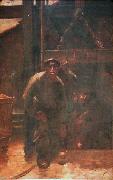 |
Constantin Meunier -- Click Here
|
|
(12 April 1831 - 4 April 1905), Belgian painter and sculptor, was born in Etterbeek, Brussels.
His first exhibit was a plaster sketch, "The Garland," shown at the Brussels Salon in 1851. Soon afterwards, on the advice of the painter Charles de Groux, he abandoned the chisel for the brush. His first important painting, "The Salle St Roch" (1857), was followed by a series of paintings including "A Trappist Funeral" (1860), "Trappists Ploughing" (1863), in collaboration with Alfred Verwee, "Divine Service at the Monastery of La Trappe" (1871) and episodes of the German Peasants' War (1878). About 1880 he was commissioned to illustrate those parts of Camille Lemonnier's description of Belgium in Le Tour du monde which referred to miners and factory-workers, and produced "In the Factory," "Smithery at Cockerill's," "Melting Steel at the Factory at Seraing" (1882), "Returning from the Pit," and "The Broken Crucible" (1884).
In 1882 he was employed by the government to copy Pedro de Campaña's "Descent from the Cross" at Seville, and in Spain he painted such characteristic pictures as "The Cafe Concert," "Procession on Good Friday," and "The Tobacco Factory at Seville" (Brussels Gallery). On his return to Belgium he was appointed professor at the Louvain Academy of Fine Arts.
In 1885 he returned to statuary and produced " The Puddler," "The Hammerer" (1886), "Firedamp" (1889, Brussels Gallery), "Ecce Homo" (1891), "The Old Mine-Horse" (1891), "The Mower" (1892), "The Glebe" (1892), the monument to Father Damien at Louvain (1893), "Puddler at the Furnace" (1893), the scheme of decoration for the Botanical Garden of Brussels in collaboration with the sculptor Charles van der Stappen (1893), "The Horse at the Pond," in the square in the north-east quarter of Brussels, and two unfinished works, the "Monument to Labour" and the Zola monument, in collaboration with the French sculptor Alexandre Charpentier.
The "Monument to Labour," which was acquired by the State for the Brussels Gallery, comprises four stone bas-reliefs, "Industry," "The Mine," "Harvest," and the "Harbour"; four bronze statues, "The Sower" "The Smith" "The Miner," and the "Ancestor"; and a bronze group, "Maternity".
Meunier died at Brussels on 4 April 1905. Constantin Meunier was a freemason, and a member of the lodge Les Amis Philanthropes of the Grand Orient of Belgium in Brussels. He was one of the cofounders of the Societe Libre des Beaux-Arts of Brussels.
In 1939, a museum dedicated to him was opened in the last house in which Meunier lived and worked, in Ixelles. Today about 150 of his works are displayed there.
|
|
 |
Constantin Lecca -- Click Here
|
|
was a Romanian painter and muralist.
|
|
 |
Constantin Hansen -- Click Here
|
|
Danish
1804-1880
Constantin Hansen Galleries
Danish painter. In 1816 he entered the Kongelige Akademi for de Sk?nne Kunster, Copenhagen, intending to study architecture; however he later became attracted to painting and worked under C. W. Eckersberg from 1828 to 1833. Around the middle of the 1820s he started developing an individual style of portraiture, which had matured by 1830. He often used his sisters and friends as models; using simple costumes, poses and compositions, he managed to endow his pictures with the intimacy and warmth that mark the Danish Golden Age. The Artist's Sisters Signe and Henriette Reading a Book (1826; Copenhagen, Stat. Mus. Kst) is a fine example of his combination of natural observation with Neo-classical idealization. Under Eckersberg, who encouraged both, he strengthened his natural flair for painting serene architectural views of Copenhagen. |
|
 |
Constantin Daniel Stahi -- Click Here
|
|
(November 14, 1844 - June 18, 1920) was a Romanian painter and gravure artist.
In 1862 he entered the National School of Fine Arts from Iaşi where he was taught by Gheorghe Panaiteanu Bardasare and Gheorghe Şiller. He continued his artistic education in Munich where, for seven years, he studied painting, metal gravure and xylography.
He painted still life paintings representing small objects that were surrounding him, such as old books, newspapers, religious items, chairs, shoes, plates and especially fruits. Also, he painted many portraits of famous people of his time (for example Gheorghe Asachi, painted in 1881). Many others of his paintings take inspiration from the simple life in the countryside in idyllic compositions and by painting peasants having as models people living in Bavaria and Moldova regions.
Beside his artistic career, he was a professor and, later on, the headmaster of the National School of Fine Arts in Iaşi between 1892 and 1902, following Gheorghe Panaiteanu Bardasare.
He died in his house on Bărboi street in Iaşi on June 18, 1920 and was interred at Eternitatea Cemetery.
|
|
 |
Constantijn Netscher -- Click Here
|
|
painted Portrait de la princesse Palatine in 1700 |
|
 |
Constant Wauters -- Click Here
|
|
painted Actors Before a Performance in 1851 |
|
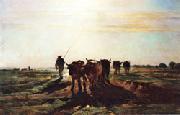 |
constant troyon -- Click Here
|
|
French Barbizon School Painter, 1810-1865 Troyon's students included Evariste-Vital Luminais. French painter. He was brought up among the Sevres ceramics workers and received his first lessons in drawing and painting from Denis-Desire Riocreux (1791-1872), a porcelain painter who was one of the founders of the Musee National de Ceramique. Troyon began his career as a painter at the Sevres factory while also studying landscape painting in his spare time. |
|
 |
Constance Mayer -- Click Here
|
|
Marie-Françoise-Constance Mayer-Lamartiniere
French Neoclassical Painter, 1775-1821 |
|
 |
Constance Marie Charpentier -- Click Here
|
|
(born 1767 Paris, France - August 3, 1849 France) was a French painter. She specialized in sentimental genre scenes and portraits, mainly children and women. She was also known as Constance Marie Bondelu.
She studied under Jacques-Louis David and Francois Gerard. In 1788 she received a 'Prix d'Encouragement.' From 1795 to 1819 she exhibited at the Salon where she received a gold medal. |
|
 |
Conrad Witz -- Click Here
|
|
1400-1446 German
(Resident in Switzerland)
Conrad Witz Gallery
-6). German painter. One of the great innovators in northern European painting, he turned away from the lyricism of the preceding generation of German painters. His sturdy, monumental figures give a strong impression of their physical presence, gestures are dignified and the colours strong and simple. Even scenes with several figures are strangely undramatic and static. The surface appearance of materials, especially metals and stone, is intensely observed and recorded with an almost naive precision. Powerful cast shadows help to define the spatial relationships between objects. His fresh approach to the natural world reflects that of the Netherlandish painters: the Master of Fl?malle and the van Eycks. He need not, however, have trained in the Netherlands or in Burgundy as knowledge of their style could have been gained in Basle. He remained, however, untouched by the anecdotal quality present in their art, while Witz pure tempera technique differs emphatically from the refined use of oil glazes that endows Netherlandish pictures with their jewel-like brilliance. |
|
 |
Conrad Wise Chapman -- Click Here
|
|
1842-1910
Conrad Wise Chapman Gallery |
|
 |
Conrad Meyer -- Click Here
|
|
Conrad Meyer (1618 - 1689) |
|
 |
Conrad Martens -- Click Here
|
|
England/Australia Painter , 1801-1878
Australian painter, lithographer and librarian of English birth. Son of a London merchant, he studied c. 1816 under Copley Fielding. His training was as a watercolourist and his most important works are watercolours, although he also produced paintings in oils. His early work displays the taste then current for the Picturesque. Francis Danby, David Cox and Turner were artists he admired. Martens left for India in 1832 or 1833 but at Montevideo joined Charles Darwin's expedition, replacing Augustus Earle as topographical draughtsman aboard the Beagle. The work strengthened his observation of detail and skill as a draughtsman. He left the expedition in October 1834 and, travelling via Tahiti and New Zealand, arrived in Sydney in April 1835. There he worked as a professional artist, in the 1840s and 1850s producing lithographic views of the Sydney area to augment his income. In 1863 he was appointed Parliamentary Librarian, which secured his finances. The skills he had acquired aboard the Beagle helped to gain him commissions to depict the estates around Sydney. However, his admiration for Turner, and with this the desire to elevate landscape as a subject, prompted him to subordinate line to mood in a Romantic treatment of the landscape. His thoughts were clearly stated in a lecture on landscape painting given in 1856 at the Australian Library, Sydney (see Smith, 1975). |
|
 |
Conrad Faber von Kreuznach -- Click Here
|
|
painted Portrait of Johann von Glauburg in 1545 |
|
 |
CONINXLOO, Gillis van -- Click Here
|
|
Flemish Northern Renaissance Painter, 1544-1607
Flemish landscape painter. His Judgment of Midas (Dresden), Latona (Hermitage, St. Petersburg), and above all the Landscape with Figures (Liechtenstein Gall., Vienna) are fine examples of his art. Coninxloo's paintings, characterized by fantasy, warm tones, and refined realism, |
|
 |
CONGNET, Gillis -- Click Here
|
|
Flemish painter (b. ca. 1538, Antwerpen, d. 1599, Hamburg)
Flemish painter. The son of a goldsmith of the same name, he trained as a painter with Lambert Wenselyns ( fl 1553) and possibly also with Antoon van Palermo (1503 or 1513-c. 1589), an Antwerp art dealer in whose house he lived (van Mander). In 1561 he became a free master in the Antwerp Guild of St Luke. Shortly afterwards he travelled to Italy, going first to Naples and Sicily and then to Terni, where he made frescoes with a painter named Stello. In 1568 he was registered as a member of the Accademia in Florence. He must have returned to Antwerp in 1570, for between that year and 1585 his name appears in the register of the city's Guild of St Luke, of which he became Dean in 1585. A year later, on the arrival of Alessandro Farnese, |
|
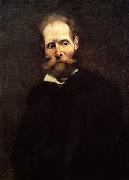 |
Columbano Bordalo Pinheiro -- Click Here
|
|
(Lisbon, 21 November 1857 - Lisbon, 6 November 1929), who is usually referred to as Columbano, was a Portuguese Realist painter. Usually considered the greatest Portuguese painter of the 19th century, he has been compared to the likes of Wilhelm Leibl and Thomas Eakins.
Columbano was the son of a mediocre romantic painter, Manuel Maria Bordalo Pinheiro, and the younger brother of the great caricaturist, Rafael Bordalo Pinheiro. He became the leading painter of his generation and the master of realism in Portuguese painting, specializing in portraiture. He was disciple of his father, of the painter Miguel Ângelo Lupi and the sculptor Simões de Almeida. After attempting twice for a bursar to study abroad finally in 1881 the countess of Edla, second wife of D.Fernando would finance his study in France. There he studied the work of French naturalist, realist and impressionist painters, like Courbet, Manet and Degas without losing his distinctive style which is often gloomy and intimist. He joined the "Grupo do Leão" (The Lion's Group), a usual meeting of artists, writers and intellectuals in a Lisbon downtown restaurant called "Leão de Ouro" (The Golden Lion) in order to discuss aesthetic issues and proclaim Naturalism against the academic art of the time. The group also included Rafael Bordalo Pinheiro, Antenio da Silva Porto, Marques de Oliveira and Jose Malhoa. He painted portraits of some of the greatest names of Portuguese society and culture of his time like Jose Maria de Eça de Queiroz, Teefilo Braga, Raul Brandão and had great psychological accuracy in defining the personality of those depicted. His most famous portrait was that of the poet Antero de Quental in 1889. In this haunting work Columbano seems to have anticipated Antero's suicide.
Columbano was a well known Republican, so it wasn't surprising that after the Republic proclamation, in 1910, he was invited to design the flag of the new regime and was nominated director of the National Museum of Contemporary Art, currently the Chiado Museum, in Lisbon, of which he was in charge from 1914 to 1927. The best collection of his paintings is in the Chiado Museum, in Lisbon. He's also represented in some of the finest Portuguese museums, like the National Museum Soares dos Reis, in Porto.
|
|
 |
Colman Samuel -- Click Here
|
|
American Hudson River School Painter , 1832-1920
was an American painter, interior designer, and writer, probably best remembered for his paintings of the Hudson River. Born in Portland, Maine, Colman moved to New York City with his family as a child. His father opened a bookstore, attracting a literate clientele that may have influenced Colman's artistic development. He is believed to have studied briefly under the Hudson River school painter Asher Durand, and he exhibited his first work at the National Academy of Design in 1850. By 1854 he had opened his own New York City studio. The following year he was elected an associate member of the National Academy, with full membership bestowed in 1862. His landscape paintings in the 1850s and 1860s were influenced by the Hudson River school, an example being Meadows and Wildflowers at Conway (1856) now in the collection of the Frances Lehman Loeb Art Center at Vassar College. He was also able to paint in a romantic style, which had become more fashionable after the Civil War. One of his best-known works, and one of the iconic images of Hudson River School art, is his Storm King on the Hudson (1866), now in the collection of the Smithsonian American Art Museum in Washington, DC. Colman was an inveterate traveler, and many of his works depict scenes from foreign cities and ports. He made his first trip abroad to France and Spain in 1860-1861, and returned for a more extensive four-year European tour in the early 1870s in which he spent much time in Mediterranean locales. |
|
 |
COLLINO, Filippo -- Click Here
|
|
b. 1737, Torino, d. 1801, Torino |
|
 |
COLLANTES, Francisco -- Click Here
|
|
Spanish Baroque Era Painter, 1599-1656
Spanish painter. He was probably a pupil of Vicente Carducho, but there is nothing to support this idea. His evident familiarity with contemporary Italian art indicates that he visited Rome and Naples, and this might explain the absence of documentation on him in Spain. Collantes enjoyed considerable prestige, and his paintings were acquired in 1634 for the decoration of the Buen Retiro Palace in Madrid; some of them may have been specially painted for this setting. His name appears frequently in the inventories of collectors in Madrid throughout the 17th century. It is impossible to date Collantes's undated paintings with any accuracy. However, his work shows two very clear and different lines of development. His canvases of large, intensely naturalistic figures, with tenebrist lighting effects , are close in style to those of Jusepe Ribera. In them the intense, energetic figures are sometimes set against landscape backgrounds, for example in St Humphrey (1645-50; Madrid, Prado) and St John the Baptist , but, still following Ribera, the naturalistic elements are emphasized. He also specialized in landscapes and in biblical or mythological subjects, compositions with minute figures set against wide landscapes or architecture with strong light effects. These are the works for which he is best known and which are the most important, since he was one of the few landscape painters in Spain in the 17th century. |
|
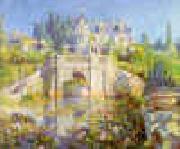 |
Colin Campbell Cooper -- Click Here
|
|
1856-1937
Colin
Campbell Cooper Galleries
Cooper was born in Philadelphia, Pennsylvania to Dr. Colin Campbell Cooper and Emily William Cooper. He studied art at the Pennsylvania Academy of the Fine Arts under Thomas Eakins, and at Acad??mie Julian in Paris.
Back in Philadelphia, he taught watercolor classes at the Drexel Institute of Art, Science and Industry (now Drexel University). In 1897 he married renowned artist Emma Lampert, and the next year they moved to New York City, where he began work on his famous skyscraper paintings.
He travelled extensively, sketching and painting scenes of Europe, Asia, and the United States in watercolors and oils. He and his wife were on the RMS Carpathia and assisted in the rescue of the survivors of the Titanic. Several of his paintings document the rescue.
In 1912, Cooper was elected to a prestigious membership in the National Academy of Design.
Cooper exhibited in San Francisco's Panama-Pacific Exposition of 1915, winning the Gold Medal for oil and the Silver Medal for watercolor. He also participated in the Panama-California Exposition in San Diego.
In 1920 his wife Emma died. He moved to Santa Barbara, California in 1921 and became dean of the School of Painting at the Santa Barbara Community School of Arts. He married his second wife, Marie Frehsee, in 1927.
Cooper died in Santa Barbara in 1937. |
|
 |
Colijn de Coter -- Click Here
|
|
painted Christ as the Man of Sorrows in c. 1500 |
|
 |
Cohoon Hannah -- Click Here
|
|
American painter
b.1788 d.1864 |
|
 |
Cogghe Remy -- Click Here
|
|
Belgian , Mouscron 1854-Roubaix 1935
|
|
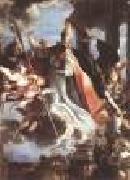 |
COELLO, Claudio -- Click Here
|
|
Spanish Baroque Era Painter, 1642-1693
Spanish painter and draughtsman. Together with the court painters Francisco Rizi, Juan Carre?o de Miranda and Francisco de Herrera, he was one of the foremost exponents of a style of Spanish painting that developed between c. 1660 and 1700 and was characterized by theatrical compositions and rich colours. The sources of this late Baroque style, which was distinct from that of the previous generation of Spanish Baroque artists, most of whom painted sober, realistic depictions of religious and secular life, lie in the influence exerted by Venetian Renaissance painting and by Italian and Flemish art of the period, |
|
 |
COECKE VAN AELST, Pieter -- Click Here
|
|
Flemish Northern Renaissance Painter, ca.1502-1550
South Netherlandish painter, architect, and linguist. After extensive travels he settled in Antwerp, where he published (1539) a Flemish translation of Vitru-vius's De Architectura and (1539?C53) Serlio's multi-volume treatise into Flemish, French, and High German.
|
|
 |
CODDE, Pieter -- Click Here
|
|
Dutch Baroque Era Painter, 1599-1678
Dutch painter and poet. Frans Hals was once thought to have been his teacher, but there is no evidence for this. It is possible that Codde studied with a portrait painter, perhaps Barent van Someren (1572/3-1632) or Cornelis van der Voort (1576-1624), since most of his earliest works, from the period 1623-7, seem to be portraits. His earliest known dated work is the Portrait of a Young Man (1626; Oxford, Ashmolean), which precedes by a year his earliest dated genre piece, the Dancing Lesson (1627; Paris, Louvre). He was particularly productive in the 1620s and 1630s, painting mainly interior genre scenes. After the mid-1640s only portraits and a few history paintings, such as the Adoration of the Shepherds |
|
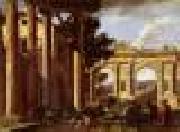 |
CODAZZI, Viviano -- Click Here
|
|
Italian Baroque Era Painter, 1604-1670
Italian painter. He arrived in Naples about 1634, having almost certainly trained in Rome. He was a specialist in the realistic architectural VEDUTA, and his interest in this theme may have been stimulated in Rome by the quadratura frescoes of Agostino Tassi and by the urban views of Claude Lorrain and Herman van Swanevelt. |
|
 |
COCK, Paul de -- Click Here
|
|
Flemish painter (1724-1801). |
|
|
|
 |
CLEVE, Joos van -- Click Here
|
|
Flemish Northern Renaissance Painter, ca.1485-1540 |
|
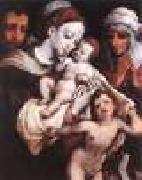 |
CLEVE, Cornelis van -- Click Here
|
|
Flemish painter, Antwerp school (b. 1520, Antwerpen, d.
after 1570, Antwerpen). |
|
 |
CLERCK, Hendrik de -- Click Here
|
|
Flemish Baroque Era Painter, ca.1570-1630
Flemish painter and draughtsman. In 1587 he was working in Rome with the Brussels painter Frans van de Kasteele. That he subsequently lived in Brussels is confirmed by documentary evidence and by his status as court painter to the governors of the southern Netherlands. Stylistically, de Clerck's work (both paintings and drawings) is close to that of the Antwerp late Mannerist Marten de Vos, traditionally thought to have been his teacher, but it is possible that he was apprenticed to Joos van Winghe in Italy. He was later a member of the Brussels painters' guild, where from 1601 to 1611 Jan van Overstraeten was registered as his pupil. It was in 1594 that de Clerck was appointed court painter in Brussels, first to Archduke Ernest. In 1596, after the Archduke's death, his brother Emperor Rudolf II arranged for de Clerck to stay on as court painter in the service of the new Archdukes, Albert and Isabella. In 1609 de Clerck and Wenceslas Cobergher were commissioned to decorate the ceiling of the oratorium in the archducal palace in Brussels |
|
|
|
 |
claudio monteverdi -- Click Here
|
|
Period: Baroque (1600-1749)
Country: Italy
Born: May 15, 1567 in Cremona, Italy
Died: November 29, 1643 in Venice, Italy
Genres: Ballet, Choral Music, Miscellaneous Music, Opera, Vocal Music
|
|
 |
Claudio Jose Vicente Antolinez -- Click Here
|
|
painted Inmaculada in 1670 |
|
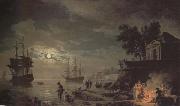 |
Claude-joseph Vernet -- Click Here
|
|
French Painter, 1714-1789
Vernet probably received his first lessons in painting from his father, Antoine, who then encouraged him to move to the studio of Philippe Sauvan (1697-1792), the leading master in Avignon. Sauvan supplied altarpieces to local churches and decorative works and mythologies for grand houses in the area. After this apprenticeship Vernet worked in Aix-en-Provence with the decorative painter Jacques Viali ( fl 1681- 1745), who also painted landscapes and marine pictures. In 1731 Vernet independently produced a suite of decorative overdoors for the h?tel of the Marquise de Simiane at Aix-en-Provence; at least two of these survive (in situ) and are Vernet's earliest datable landscapes. These are early indications of his favoured type of subject, and Vernet would have studied works attributed to such 17th-century masters as Claude Lorrain, Gaspard Dughet and Salvator Rosa in private collections at Aix and Avignon. Three years later Joseph de Seytres, Marquis de Caumont, who had previously recommended Vernet to the Marquise de Simiane, offered to sponsor a trip to Italy. |
|
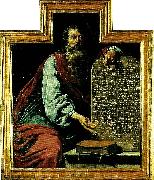 |
claude vignon -- Click Here
|
|
Claude Vignon (19 May 1593 - 10 May 1670) was a leading French painter and engraver working in the Baroque manner.
He was born at Tours and received early training in Paris. About 1610 he travelled to Rome where his mature style was formed in the circle of French painters there that included Simon Vouet and Valentin de Boulogne, a prominent member of the Caravaggisti working, like Bartolomeo Manfredi, in the manner established by Caravaggio.
He returned from Italy, after a tour in Spain, in 1623. His paintings are represented in most of the major museums. |
|
 |
Claude Monet -- Click Here
|
|
French Impressionist Painter, 1840-1926
Claude Oscar Monet (14 November 1840 C 5 December 1926) was a founder of French impressionist painting, and the most consistent and prolific practitioner of the movement's philosophy of expressing one's perceptions before nature, especially as applied to plein-air landscape painting. The term Impressionism is derived from the title of his painting.
Claude Monet was born on 14 November 1840 on the fifth floor of 45 rue Laffitte, in the ninth arrondissement of Paris . He was the second son of Claude-Adolphe and Louise-Justine Aubree Monet, both of them second-generation Parisians. On 20 May 1841, he was baptised into the local church parish, Notre-Dame-de-Lorette as Oscar-Claude. In 1845, his family moved to Le Havre in Normandy. His father wanted him to go into the family grocery store business, but Claude Monet wanted to become an artist. His mother was a singer.
On the first of April 1851, Monet entered the Le Havre secondary school of the arts. He first became known locally for his charcoal caricatures, which he would sell for ten to twenty francs. Monet also undertook his first drawing lessons from Jacques-François Ochard, a former student of Jacques-Louis David. On the beaches of Normandy in about 1856/1857 he met fellow artist Eugene Boudin who became his mentor and taught him to use oil paints. Boudin taught Monet "en plein air" (outdoor) techniques for painting.
On 28 January 1857 his mother died. He was 16 years old when he left school, and went to live with his widowed childless aunt, Marie-Jeanne Lecadre.
After several difficult months following the death of Camille on 5 September 1879, a grief-stricken Monet (resolving never to be mired in poverty again) began in earnest to create some of his best paintings of the 19th century. During the early 1880s Monet painted several groups of landscapes and seascapes in what he considered to be campaigns to document the French countryside. His extensive campaigns evolved into his series' paintings.
Camille Monet had become ill with tuberculosis in 1876. Pregnant with her second child she gave birth to Michel Monet in March 1878. In 1878 the Monets temporarily moved into the home of Ernest Hosched, (1837-1891), a wealthy department store owner and patron of the arts. Both families then shared a house in Vetheuil during the summer. After her husband (Ernest Hoschede) became bankrupt, and left in 1878 for Belgium, in September 1879, and while Monet continued to live in the house in Vetheuil; Alice Hosched helped Monet to raise his two sons, Jean and Michel, by taking them to Paris to live alongside her own six children. They were Blanche, Germaine, Suzanne, Marthe, Jean-Pierre, and Jacques. In the spring of 1880 Alice Hosched and all the children left Paris and rejoined Monet still living in the house in Vetheuil. In 1881 all of them moved to Poissy which Monet hated. From the doorway of the little train between Vernon and Gasny he discovered Giverny. In April 1883 they moved to Vernon, then to a house in Giverny, Eure, in Upper Normandy, where he planted a large garden where he painted for much of the rest of his life. Following the death of her estranged husband, Alice Hosched married Claude Monet in 1892.
|
|
 |
Claude Marie Dubufe -- Click Here
|
|
painted Portrait de la marechale duchesse de Feltre in before 1852 |
|
 |
claude lorraine -- Click Here
|
|
Claude Lorrain (also Claude Gell??e or Le Lorrain) (Lorraine, c. 1600 ?C Rome, 21 or 23 November 1682) was an artist of the neo-classical era who was active in Italy, and is admired for his achievements in landscape painting. |
|
 |
Claude Lorrain -- Click Here
|
|
French
1600-1682
Claude Lorrain Galleries
In Rome, not until the mid-17th century were landscapes deemed fit for serious painting. Northern Europeans, such as the Germans Elsheimer and Brill, had made such views pre-eminent in some of their paintings (as well as Da Vinci in his private drawings or Baldassarre Peruzzi in his decorative frescoes of vedute); but not until Annibale Carracci and his pupil Domenichino do we see landscape become the focus of a canvas by a major Italian artist. Even with the latter two, as with Lorrain, the stated themes of the paintings were mythic or religious. Landscape as a subject was distinctly unclassical and secular. The former quality was not consonant with Renaissance art, which boasted its rivalry with the work of the ancients. The second quality had less public patronage in Counter-Reformation Rome, which prized subjects worthy of "high painting," typically religious or mythic scenes. Pure landscape, like pure still-life or genre painting, reflected an aesthetic viewpoint regarded as lacking in moral seriousness. Rome, the theological and philosophical center of 17th century Italian art, was not quite ready for such a break with tradition.
In this matter of the importance of landscape, Lorrain was prescient. Living in a pre-Romantic era, he did not depict those uninhabited panoramas that were to be esteemed in later centuries, such as with Salvatore Rosa. He painted a pastoral world of fields and valleys not distant from castles and towns. If the ocean horizon is represented, it is from the setting of a busy port. Perhaps to feed the public need for paintings with noble themes, his pictures include demigods, heroes and saints, even though his abundant drawings and sketchbooks prove that he was more interested in scenography.
Lorrain was described as kind to his pupils and hard-working; keenly observant, but an unlettered man until his death. The painter Joachim von Sandrart is an authority for Claude's life (Academia Artis Pictoriae, 1683); Baldinucci, who obtained information from some of Claude's immediate survivors, relates various incidents to a different effect (Notizie dei professoni del disegno).
John Constable described Claude Lorrain as "the most perfect landscape painter the world ever saw", and declared that in Claude??s landscape "all is lovely ?C all amiable ?C all is amenity and repose; the calm sunshine of the heart" |
|
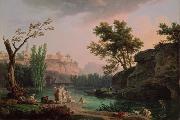 |
Claude Joseph Vernet -- Click Here
|
|
Claude-Joseph Vernet (14 August 1714 - 3 December 1789) was a French painter. His son, Antoine Charles Horace Vernet, was also a painter.
Vernet was born in Avignon. When only fourteen years of age he aided his father, Antoine Vernet (1689-1753),[1] a skilled decorative painter, in the most important parts of his work. The panels of sedan chairs, however, could not satisfy his ambition, and Vernet started for Rome. The sight of the sea at Marseilles and his voyage thence to Civitavecchia (Papal States' main port on the Tyrrhenian Sea) made a deep impression on him, and immediately after his arrival he entered the studio of a marine painter, Bernardino Fergioni.
Slowly Vernet attracted notice in the artistic milieu of Rome. With a certain conventionality in design, proper to his day, he allied the results of constant and honest observation of natural effects of atmosphere, which he rendered with unusual pictorial art. Perhaps no painter of landscapes or sea-pieces has ever made the human figure so completely a part of the scene depicted or so important a factor in his design. In this respect he was heavily influenced by Giovanni Paolo Panini, whom he probably met and worked with in Rome. Vernet's work draws on natural themes, but in a way that is neither sentimental or emotive. The overall effect of his style is wholly decorative.[2] "Others may know better", he said, with just pride, "how to paint the sky, the earth, the ocean; no one knows better than I how to paint a picture". His style remained relatively static throughout his life. His works' attentiveness to atmospheric effects is combined with a sense of harmony that is reminiscent of Claude Lorrain. |
|
 |
Claude Gillot -- Click Here
|
|
(April 28,1673 Langres - May 4,1722 Paris) was a French painter, best known as the master of Watteau and Lancret. He had Watteau as an apprentice between 1703 and 1708.
He was a painter, engraver, book illustrator, metal worker, and designer for the theater.
His sportive mythological landscape pieces, with such titles as Feast of Pan and Feast of Bacchus, opened the Academy of Painting at Paris to him in 1715; and he then adapted his art to the fashionable tastes of the day, and introduced the decorative fetes champetres, in which he was afterwards surpassed by his pupils. He was also closely connected with the opera and theatre as a designer of scenery and costumes.
|
|
 |
Claude Deruet -- Click Here
|
|
(1588-1660) was a famous French Baroque painter of the 17th century, from the city of Nancy.
Deruet was an apprentice to Jacques Bellange, the official court painter to Charles III, Duke of Lorraine. He was in Rome between ca. 1612 and 1619, where - according to Andre Felibien - he studied with the painter and etcher Antonio Tempesta. During his stay in Rome, he painted the Japanese samurai Hasekura Tsunenaga on a visit to Europe in 1615.
Deruet was made a noble by the Duke of Lorraine in 1621, and was then made a Knight of the Order of St Michel in 1645 by Louis XIII, who had in 1641 absorbed most of Lorraine into France. He had a luxurious residence in Nancy, named La Romaine, where Louis XIII and his Queen stayed in 1633.
Claude Lorrain was an apprentice to Claude Deruet in 1623 for one year. He also married and had two sons, one of whom became a painter.
|
|
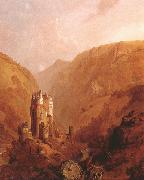 |
Clarkson Frederick Stanfield -- Click Here
|
|
English Painter, 1793-1867
He is often wrongly referred to as William Clarkson Stanfield. The son of Mary Hoad and James Field Stanfield, an Irish actor and author, he was apprenticed to a heraldic coach painter at the age of 12, but in 1808 he abandoned this and went to sea in a collier. In 1812 he was press-ganged and spent two years on HMS Namur, the guard-ship at Sheerness. After being discharged as the result of an injury in 1814, he joined the merchant navy, sailing to China in the Indiaman Warley in 1815. Soon after his return in 1816 he missed his ship and became a scene painter, first at the Royalty Theatre, Stepney, and then at the Royal Coburg, Lambeth. There he was later joined by David Roberts, who became a lifelong friend, and in 1822 both men were employed as scene painters at the Theatre Royal, Drury Lane. During the next 12 years Stanfield established himself as the most talented scene painter of his day, causing a sensation with some of his huge moving dioramas such as the scenes of Venice in the pantomine Harlequin and Little Thumb (1831). Meanwhile he was building an equally impressive reputation as an easel painter. He first exhibited at the Royal Academy in 1820 and continued to exhibit there regularly until his death. He was elected ARA in 1832 and RA in 1835. |
|
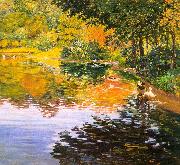 |
Clark, Kate Freeman -- Click Here
|
|
American, 1875-1922 |
|
 |
Clarice Beckett -- Click Here
|
|
Australian Painter, 1887-1935,Australian painter. She studied at the National Gallery School, Melbourne (1914-16), and with Max Meldrum became involved (c. 1917) with the Meldrum circle of artists, which included Colin Colahan (1897-1987), Justus Jorgensen (1893-1975), John Farmer (b 1897) and Percy Leason (1889-1959). In 1919 she moved to the seaside suburb of Beaumaris, where she lived and worked for the rest of her life. |
|
 |
Clarence a gagnon -- Click Here
|
|
Canadian Painter, 1881-1942
was a Quebecois painter. A native of Montreal, he studied at the Art Association of Montreal in 1897. Early in life, his mother had encouraged him to learn drawing and painting, but his father wanted him to become a businessman. Desiring to improve his knowledge about art, he went to the Academie Julian, Paris, and studied under Jean-Paul Laurens from 1904 to 1905. He then lived in Baie-Saint-Paul, where he produced many paintings depicting nature and the Canadian people. He invented a new kind of winter landscape that consisted of mountains, valleys, sharp contrasts, vivid colours, and sinuous lines. He became a member of the Royal Academy of the Arts in 1910. Gagnon took a trip to Venice, Rouen, Saint-Malo and the Laurentians to paint landscapes. He illustrated the pages of the novel Maria Chapdelaine by Louis Hemon. As well, he was the illustrator for Louis-Frederic Rouquette in 1929 in the white silence. He lived in France from 1924 to 1936. Gagnon opened modernity painting within Canada. He died in 1942. One of his disciples is the painter Rene Richard. |
|
|